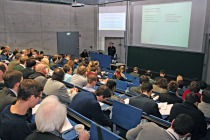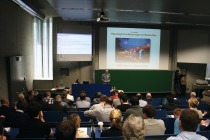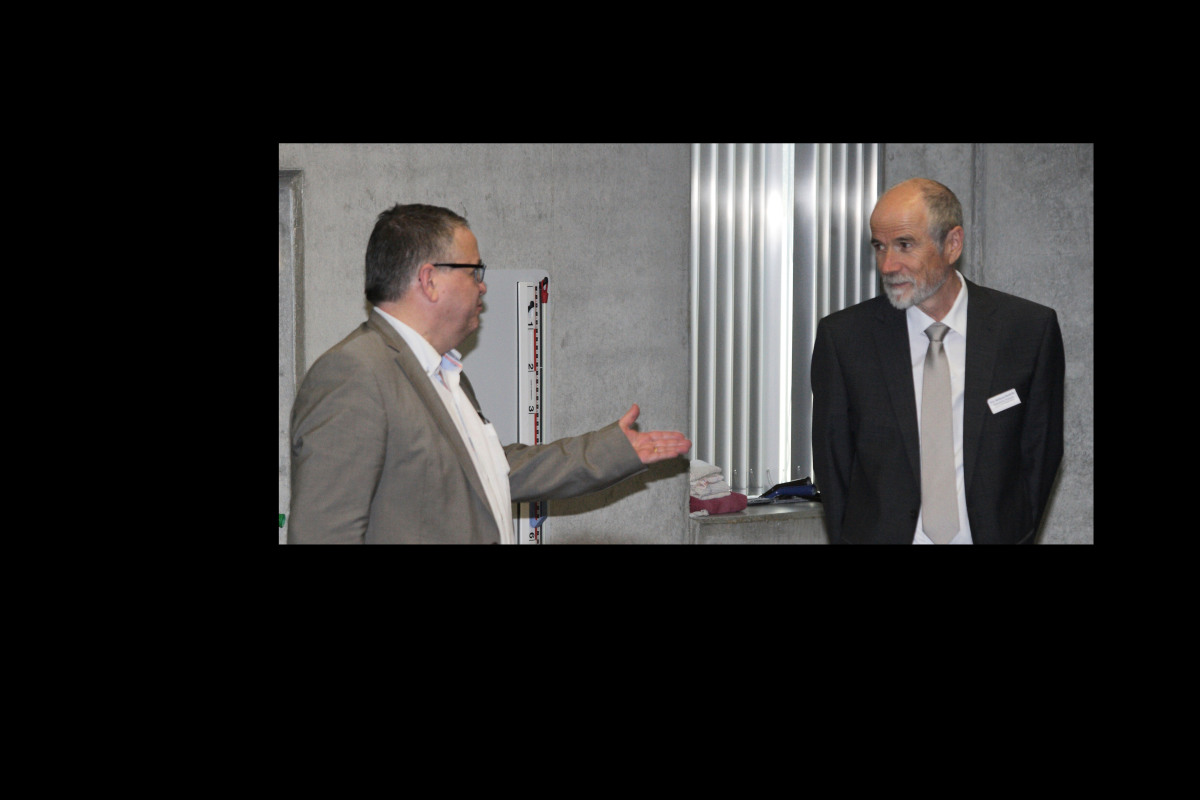“Rheological measurements on building materials”
Building materials scientists coming from all over the world appeared not that impressed by the international crisis. Almost the same number of participants as last year found their way to Regensburg, in order to gather information about the results of the latest research in the field of rheology of building materials. Owing to the fact that there were speakers coming from six nations from India to Iceland and visitors from more than 10 countries, it was reasonable for the organizers – the Regensburg University and company Schleibinger – to speak of an international conference.
Peter Ramge of BAM in Berlin (German Federal Institute for Material Research and Testing) presented the influence of different storage conditions of cement on the rheological properties of mortar. The hydration products on the surface of cement particles verified by means of an electron microscope do obviously have an influence on the slump flow and the rheologically determined yield point.
Dr. Stark of the University of Weimar devoted her speech to sand as further starting material of mortar. Reason for her research project is the replacement of natural sand by crushed sand. With the aid of modern optical measurement systems, she was able to investigate beside the particle-size distribution, the particle shape and its influence on the yield point of mortar. The rheological measurements were carried out by using a basket probe according to Prof. Vogel.
By means of modern oscillation measuring systems, Steffen Schneider of Knauf Gips KG investigated the behavior at rest as well as the processing behavior of plasters and joint compounds.
The behavior at rest in case of modern concrete is likewise of great interest. If mortar or concrete are not stable at rest, this leads to sedimentation of the aggregates. It is well known that a self-compacting concrete has to have as well thixotropic properties, if it shall flow easily and shall be stable nonetheless. Dirk Lowke of the TU Munich presented a new theory regarding this topic. In his approach he could demonstrate that the close-range and long-range effect among the fine particles are influenced in a different way by the superplasticizer and the water. This effect may result in the fact that a SCC with more water and a lesser amount of water in the application is even more robust.
The effect of modern superplasticizers is depending, among other things, on the temperature. Dr. Golaszweski of the University of Technology in Gliwice, Poland demonstrates that this effect often cannot be detected or may incorrectly be detected in cement pastes. Therefore, a rheological measurement on mortar is indispensable.
In Germany SCC is traditionally manufactured with a relatively high binder content. Florian Müller, Innovation Center Iceland, presented a somewhat different mixture design with lower binder content. In this way, a SCC can be produced which flows faster, i.e. being low viscous but nevertheless stable.
The so-called geopolymer concrete presented by Prof. Malathy of the Kongu Eng. College, India, does without any cement at all. For this concrete ash, in particular fly ash, is used together with a chemical activator as binding agent.
The actual concrete pressure when concreting SCC is still not definitely known, therefore the hydrostatic concrete pressure is generally taken as a basis. Carsten Bohnemann of the RWTH Aachen has conducted comprehensive test series in this respect. Interestingly, there is no difference concerning the concrete pressure in case of high-viscosity and low-viscosity SCC. If the concreting speed is not too high, the pressures are even lower than in case of vibrated concrete. This, however, does not apply when pouring the concrete bottom-up by means of pumps. In this case, the hydrostatic pressure actually has to be taken as the basis.
Dr. Kumar, Granit Constr. Company of Abu Dhabi, among other things presented the test methods applied in Abu Dhabi for steel fiber-reinforced SCC.
The suitability of alkali-free accelerators for sprayed concrete so far may only be assessed in quite extensive spraying tests. Peter Iff of Bilfinger Berger AG, laboratory Munich, has developed together with the University of Nuremberg a laboratory testing method. Since the processes in this method are running extremely fast, classical rheometer and oscillation tests do not provide definite results. Therefore, further tests were carried out by means of the SEM cryoscopy. In this way, the hydration is interrupted by immersing in supercooled nitrogen. Afterwards, the samples are evaluated in the scanning electron microscope.
At the end of the event, Prof. Yilmaz, Istanbul University, Turkey, presented the project of an underwater pipeline from the Turkish Taurus to Cyprus and expanding to the Middle East. For this purpose, a plastic pipe was anchored in a water depth of about 200 m floating on the bottom of the sea. Owing to many problems, as well in fluidic and rheologic respect, this project becomes an
engineering challenge.
After a pleasant get-together and informal exchange of experiences in the evening, a laboratory workshop took place on the 12th of March imparting rheological principles and performing practical building measurements.
The next colloquium will presumably take place in the second week of March 2010 again at the University of Regensburg.
Address/Anschrift
Schleibinger Geräte
Teubert u. Greim GmbH
Gewerbestraße 4
84428 Buchbach/Germany
Tel.: +49 8086 94010
Fax: +49 8086 94014
Mobil: +49 172 8 999 196
greim@schleibinger.com
www.schleibinger.com



